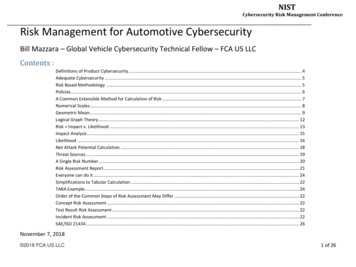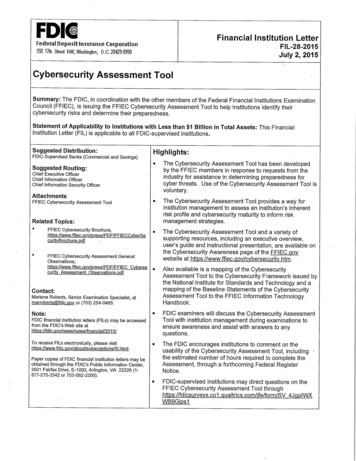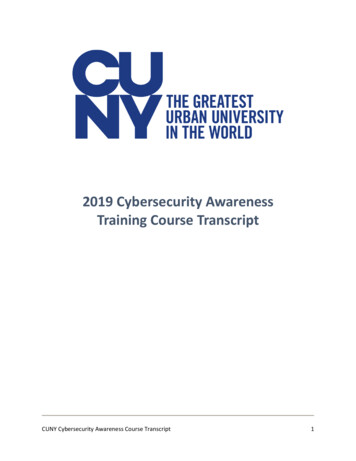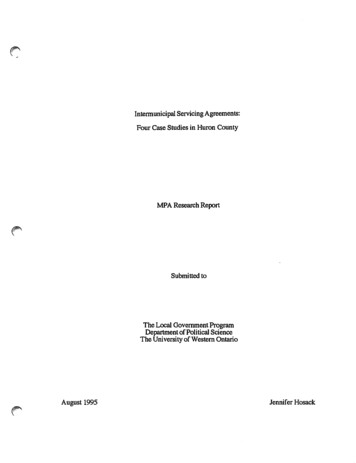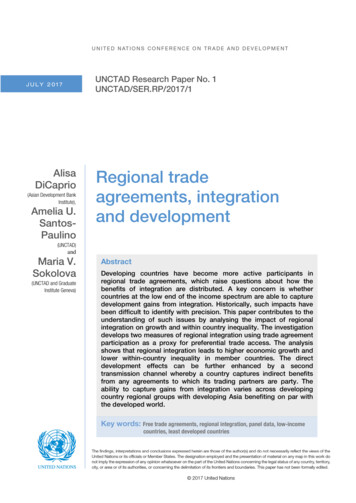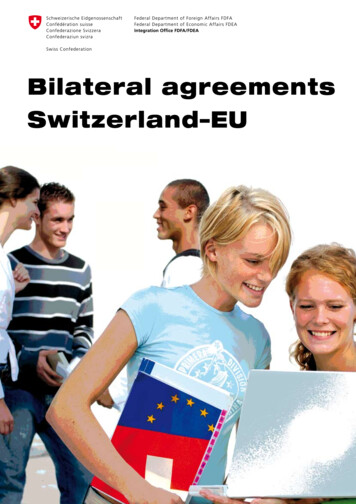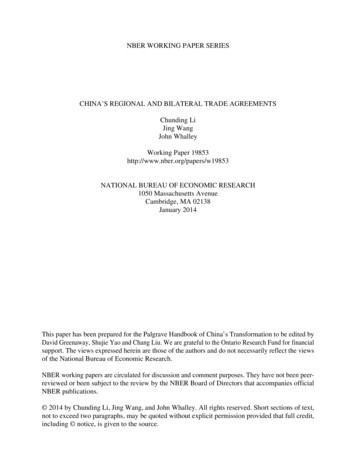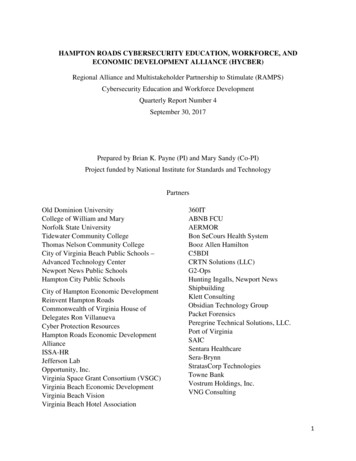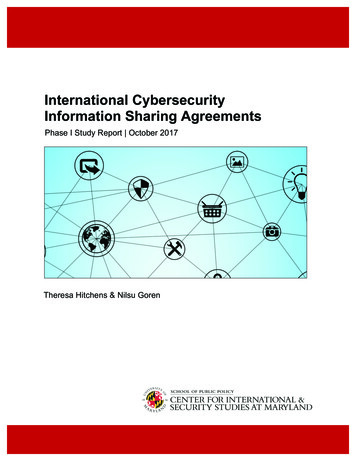
Transcription
International CybersecurityInformation Sharing AgreementsPhase I Study Report October 2017Theresa Hitchens & Nilsu GorenInternational Government Cybersecurity Information Sharing Agreements1
Acknowledgements: This report was prepared as part of CISSM's Multi-stakeholder Approachto Cybersecurity Risk Management Project, with support from the Laboratory forTelecommunications Sciences. The authors would like to thank graduate assistants Jeremy Hikenand Renuka Pai for their work in support of this project.International Government Cybersecurity Information Sharing Agreements2
IntroductionCybersecurity transcends national boundaries in many ways: The internet’s technicalinfrastructure is global in scope; threat actors based in one country can disguise their identitiesby taking control of computers in other countries; global businesses sell software, hardware, andsecurity services that may introduce or combat vulnerabilities; and the consequences from adisruptive attack can spread far beyond the initial victim. Even the most cyber-savvy countrycannot protect itself completely unless it wants to disconnect from the global internet and strictlylimit who can use information technology and for what purposes inside its own borders. And thiscourse of action is infeasible because it would result in dire consequences for the nationaleconomy, military, and all other systems that depend on advanced information technology.International cooperation to improve cybersecurity is a much more realistic and viable path.Information sharing is the most commonly promoted type of international cooperation, but verylittle is known about what type of cybersecurity information is currently being shared withwhom, for what purposes, and under what conditions.As a first step towards answering this larger question, the International CybersecurityInformation Sharing Project undertook to survey, catalog, and analyze publicly availablegovernment-to-government cybersecurity-related sharing agreements to determine what types ofinformation various governments have committed to share, and to identify gaps in informationsharing. The ultimate aim of the larger project is to assess how multilateral cybersecurity sharingpractices can be encouraged and improved in order to strengthen global cybersecurity.The project team started from the assumption that formal cyber sharing agreements andmemoranda of understanding (MoU) are an important part of the foundation for the developmentof norms on cyber cooperation. Over the past several years, various international fora havereiterated that sharing information about cyber threats and vulnerabilities, national approaches tocyber protection, best practices, incidents of concern, and response mechanisms could increasemutual cybersecurity while reducing risks of misunderstandings and conflict.Different types of information sharing can be used to improve cybersecurity in various ways. Bysharing threat perceptions and national policies, states can better understand each other’sconcerns and priorities. By conducting multilateral exercises and sharing best practices forprotection of networks, critical infrastructure, and software/hardware, states can help each otherensure safe data transfer across borders. Cooperation to build capacity in states with weakerinfrastructure for managing the use of information and communications technologies (ICTs) canhelp in identifying threats and responding to crises.This research found that cybersecurity information agreements are more numerous, but lessspecific than anticipated. The project documented and analyzed 196 agreements involving 116different countries and 2,349 signatures. Extensive signature of agreements and associatedcommentary shows widespread accord on the principle that information sharing is necessary.However, it is unclear how much and what type of information sharing occurs in practice. Fewagreement texts are public, and those that are often use vague language. And, despite thepotential benefits of sharing more cyber-security information, many disincentives and logisticalInternational Government Cybersecurity Information Sharing Agreements3
barriers remain. This project collected as much information as possible, not only about whatstates have agreed to do, but also what they actually do, and why they make those choices.After a brief summary of the approach taken and some limitations encountered, the studyprovides summary statistics about international cyber information sharing agreements. It thenlooks in more detail at sharing agreements and behaviors by some of the most active and/orimportant countries in regional organizations, and in multilateral fora that have focused on thistopic. A summary of key findings, conclusions, and next steps is followed by annexes with moremethodological information and texts for some of the most important agreements.ApproachCybersecurity is defined broadly as: measures taken to protect a computer or computersystem against unauthorized access or attack. Numerous actors besides states are engaged incybersecurity cooperation, including private companies, universities, and non-governmentalorganizations. Moreover, government-to-government cooperation usually is not focused on highlevel legal arrangements. Instead, it is spread out to include governmental agency-to-agencyactivity, government-sponsored fora for exchange of information, non-governmentalorganization meetings, and membership organization meetings such as at regional forums. Thus,the scope of the research was widened to include these sorts of formal and informal activities, aslong as they were at least somewhat institutionalized rather than purely ad hoc, and involvedsharing information about cybersecurity for primarily non-commercial purposes. Given thedifferences among countries in cyber-related terminology, agreements about information andcommunications technology (ICT) that fit these criteria were also included even though they didnot use the term “cybersecurity.”Rather than attempt a world-wide survey, this initial project focused on members of majorregional organizations that have shown particular interest in cybersecurity: the Organization forSecurity and Cooperation in Europe (OSCE), NATO, the European Union (EU), the Associationof Southeast Asian States (ASEAN), and the Shanghai Cooperation Organization (SCO). Thismeans that African, Latin American, and Middle Eastern countries are under-represented in thecurrent survey. This decision enabled us to spend available time and resources to develop a morecomplete picture of cooperation involving the most active countries.Data collection was built on the International Telecommunication Union’s (ITU) cybersecuritymaturity reports on 195 countries, and on the 2013 literature survey “The Cyber Index:International Trends and Realities.”1 To find additional multilateral, regional, and bilateralagreements, CISSM researchers scoured English-language news media, trade publications, andother documents. Additional information was collected about the most important agreements bycontacting government officials and cybersecurity experts. Using only English-language opensources of information may have reduced the relative number of agreements researchers foundinvolving non-English speaking countries that do not get extensive attention from Englishlanguage media sources.1Theresa Hitchens, ed., “The Cyber Index: International Trends and Realities,” United Nations Institute forDisarmament Research, 2013, r-index-2013-en-463.pdfInternational Government Cybersecurity Information Sharing Agreements4
The third limitation of the survey was that it could only capture what was available in the publicdomain. Researchers found that few agreement texts have been made public in full, beyondmedia statements indicating the intent to cooperate or that a memorandum of understanding(MoU) on cybersecurity was recently signed. Further, those agreements that are in the publicdomain are often vague, making it difficult to assess the actual impact or implementation of theagreements. Even more difficulty was encountered in documenting incidents where suchagreements have been invoked or utilized, perhaps due to reluctance on the part of governmentsto publicly discuss breaches of information or networks. Understandably, details of technicalinformation sharing agreements between Computer Emergency Readiness Teams (CERT) werealso not publicized. However, patterns of cooperation are visible and can be used to elucidatesome questions about how states interact with regards to cybersecurity.Even with limits imposed by geographical scope, language constraints, and the classified orsensitive nature of the cybersecurity sphere, researchers found a surprisingly large number ofagreements, often involving more than two signatories. At a macro-level, the researchdocumented 196 agreements involving 116 countries. In total, these agreements involve 2,349signatures when broken down by type.The agreements were categorized into the following types:Training – Agreements that involve training of personnel, either mutual or in one direction.Research – Agreements that involve working together on research about risks, threats,methodologies for detection of intrusions, etc.Policy – General cooperation agreements that include exchanges on cybersecurity policies, laws,identification of critical infrastructure, at a government-to-government level.Information Sharing – The most general of the agreement types, ranging from high-levelpolitical agreements to agency-to agency agreements to share a broad, or vague, scope ofinformation regarding cybersecurity.Military – Agreements that specify cooperation between ministries of defense, and/or militaryforces.Cyber Operations – Agreements that involve countries working together to thwart cybersecuritybreaches, build up cyber defenses, technical cooperation on protection, detection andincident response, and CERT-to-CERT agreements.Cyber Exercises – Agreements that involve conduct of joint exercises and simulations practicingcyber defense or response operations.Cyber Crime – Agreements on sharing information, coordinating defenses and responses, and/orjoint investigations into cyber crime incidents.International Government Cybersecurity Information Sharing Agreements5
Best Practices – Agreements involving sharing of best practices for cyber protection,notifications, incident response and recovery, etc.Any categorization scheme is bound to be somewhat subjective, and the research team found thatmany agreements fit multiple categories. Thus, the number of agreements by category for anygiven state is larger than the actual number of signed agreements. See Annex 1 on researchmethodology for more details.The Military category was established to document agreements directly involving defenseministries and/or militaries, although a number of Policy and Information Sharing agreementstalk in terms of sharing information on cyber defense that could involve ministries of defense ormilitary bodies. This reflects the fact that not all nations consider cybersecurity to be a functionfor military forces or a national defense problem, but a problem of crime and/or internal security.For those that involve national militaries, agreement texts tend to be vague.Overall, the bulk of activity breaks down by type as: Cyber Operations (425), InformationSharing (412), Policy (339), Cyber Crime (306), Research (255), Military (189), Training (187),Best Practices (125), Cyber Exercises (98), and unspecified (4).Total Signatures ( 2349) by Agreement MilitaryInformation Sharing421425Cyper OperationsCyber Exercises98Cyber Crime306Best Practices125050100150200250300350400450This overview of agreements by type indicates that currently much cyber information sharing isat a basic level of awareness raising, as states try to improve their own national technicalcapabilities, policies, and approaches by learning from others. The large number of CyberOperations agreements shows that improving technical skills is high on the agenda of manystates, and reflects the existence of many CERT-to-CERT arrangements. The high number ofCyber Crime agreements is also easily explained, as crime in the cybersphere has been on theinternational agenda since the late 1990s and is an arena where most states have strongincentives to cooperate.Officials involved in cybersecurity information sharing from various states have noted that muchactivity takes place behind the scenes or in informal settings such as conferences. For example,International Government Cybersecurity Information Sharing Agreements6
states do not often publicize requests for information in the aftermath of an incident, but it isknown that the U.S. government privately contacted a number of other states in the wake of theSony hack to request forensic assistance and alerted a number of states regarding U.S. attributionof the hack to North Korea.One impediment to international information sharing in incident response, according tonumerous officials, is poor internal state coordination (a “whole of government response,” as oneofficial put it) on a timely basis. This is as true for even the most sophisticated cyber states, aswell as for less advanced states. For sophisticated states, such as the United States and the U.K.,the issue is setting up inter-departmental authorities, responsibilities, and accountability wheremany bureaucracies have “pieces” of information and partial authority, as well as differentpriorities. In smaller and less advanced states, the critical issue is capacity building andestablishing authorities for cybersecurity. Informal conferences, often at the Track-1.5 level, areoften used to both share information more freely, and to set up bilateral or small multilateralconversations.Fewer states cooperate in the area of military activities and national security-related networkprotection. This is not surprising, given that secrecy regarding national security capabilities inthe cybersphere is currently considered paramount, particularly as many nations seek to leveragecyber tools for offensive military operations, but it may be short-sighted. This factor weighsheavily against the success of cooperation to improve the overall level of internationalcybersecurity in the absence of major international incidents, because of the tension between theneed to cooperate to raise the barriers to cyber exploitation by malicious actors with the need toprotect one’s own perceived national security requirements.Country Levels of Activity2The countries covered in this survey fall into three levels of sharing activity:Low: The members of the largest group (71 countries) have only a few sharing arrangementseach (in the single digits), generally as a member of a regional or sub-regional arrangement.Medium: A mid-sized group of countries (40) have agreements numbering in the teens and 20s.This group is composed largely of Western countries, as well as several especially activemembers of ASEAN including China (23) and Japan (26). NATO members and partner countriesmake up the bulk of this category. One surprising member is Malaysia (24 agreements). Perhapsthis is due to its status as a geographical cable hub for internet communications in the region.Another surprise is India, which has 29 agreements, despite its relative status as a newcomer tocybersecurity efforts. Russia comes in at the low end of this group, with only 12 agreements.High: The smallest category is of “super sharers,” with agreements numbering in the 30s orabove. Countries in this category are: the U.S. (51), the U.K. (42), the Netherlands (38), Spain(35), and France (30). The governments of these countries have made cybersecurity a priorityissue. For example, the U.K. Foreign Ministry in 2011 launched the Global Conference on2Excel charts of each major country’s agreements are found in the Annexes.International Government Cybersecurity Information Sharing Agreements7
Cyberspace, to promote an open cyberspace; the Netherlands, another super sharer, hosted thefourth conference in 2015. Both the Netherlands and Spain have been particularly active inoutreach to Middle Powers, and to developing nations in Africa and Latin America.International Government Cybersecurity Information Sharing Agreements8
CountryCountries ( 47) With 10 AgreementsThailandMaltaIrelandBrunei DurussalamNew ZealandChileRussian FederationAustriaViet landRepublic of ungaryBulgariaAustraliaBelgiumJapanDenmarkCzech etherlandsUnited KingdomUnited States of 30374240515060Number of SignaturesInternational Government Cybersecurity Information Sharing Agreements9
Beyond the Numbers: Cyber information sharing by and among key countriesRussia, China and the U.S.Russia, China and the U.S., as major geopolitical competitors, have strained relationships in thecybersphere. The strains are not only based on concerns about cyber espionage for economic orpolitical gain and potential military use of cyber tools during warfare, but also upon afundamental philosophical disconnect. Whereas the U.S. champions free speech, global access toinformation, and a multi-stakeholder approach to internet governance, China and Russia arepushing for stronger “national sovereignty” in the cybersphere, meaning the right to ensurecontrol of information content accessible to their citizens and protection of the national politicalsphere from outside interference via what their governments see as disruptive information. Forexample, while the U.S. and most Western countries use the term “cybersecurity” to discussprotection of networks and individuals from cyber intrusions, China and Russia (and somedeveloping nations) use the term “information security” to encompass not just data protection butalso content protection and use of information deemed by national laws as criminal, which caninclude sharing of information criticizing government policies and actions.Russia and China were the architects of the Shanghai Cooperation Organization (SCO) proposalto the United Nations—introduced in 2011 and most recently updated in January 2015—for an“International Code of Conduct for Information Security” that seeks to establish an internetgovernance structure that lets national governments control content.3 The Code proposal hasbeen rejected by most Western states, due to freedom of information concerns. This ideologicalschism is not new to the Information Age, but reflects the longstanding tensions among differingsocietal constructs with regards to citizens’ rights and responsibilities towards the state and thecentral government. At the multilateral level, this foundational gap has seen Russia and Chinacontinuing to take a leading role in promoting the concept of state control in the cybersphere in anumber of fora, including at the United Nations in discussions of cyber norms of behavior underthe Group of Governmental Experts on Information Security processes, within the InternationalTelecommunication Union, and on the question of internet governance.Cyber sharing activity among the major global powers reflects these differences in ideology andgeopolitical goals. For example, likeminded Western states are the most open in sharing witheach other information across all categories, including political agreements that champion humanrights and freedom of information in the cybersphere. Russia, on the other hand, has limitedsharing on cyber crime due to its perception that allowing outside states to be involved ininvestigations of criminal behavior in the cybersphere may compromise its national sovereignty.Both China and Russia have signed agreements that seek to improve their capacity, and that ofother likeminded states, at the central government level to block certain information from theview of the wider citizenry.3Henry Roigas, “An Updated Draft of the Code of Conduct Distributed in the United Nations: What’s New?” Feb.10, 2015, Incyder News, NATO Cooperative Cyber Defense Center of Excellence, ibuted-united-nations-whats-new.htmlInternational Government Cybersecurity Information Sharing Agreements10
United StatesThe United States has the largest number of cyber sharing agreements by far, with a total of 51across the nine categories. By type, the U.S. has 100 agreements. Information Sharing, Researchand Cyber Operations are the categories with the most activity, followed by Cyber Crime. Thereare nine agreements in the Military category, not counting the NATO Cyber Defense Policy as awhole. The U.S. has been most active over the last decade in outreach to other nations, both toachieve sharing agreements and to build capacity in the cybersphere (this includes promotingcyber literacy and use of ICTs) among allied and friendly nations. U.S. officials say that theNational Security Agency (NSA) regularly informs allied countries when it detects cyberoperations against them. For example, in the spring of 2017 the NSA reached out to thecampaign of Emmanuel Macron during the French presidential elections after discoveringsuspected Russian intrusion into the campaign’s operations.4 Much of this outreach has beencentered on practical cooperation rather than political cooperation, despite the fact that the U.S.is the leading promoter of the multi-stakeholder model of internet governance. As the countrymost invested in the internet economy, and with the most advanced domestic internetarchitecture, this focus on technical cooperation is perhaps to be expected.USA Signatures ( 100) by Agreement Type9Training14Type of AgreementResearchPolicy89MilitaryInformation Sharing19Cyber Operations195Cyber Exercises11Cyber CrimeBest Practices605101520Number of SignaturesChinaChina has 23 agreements in total, breaking into 45 by type with Cyber Crime, Best Practices andInformation Sharing as the most common. China has 15 bilateral agreements with 12 countries—including the 2015 framework agreement with the U.S.—four of which are with Indonesia andtwo with Russia. The Indonesian agreements focus on cyber crime and capacity building. Chinahas no Military agreements; however, news reports in late January 2016 cited a top Indonesiancyber official as stating that China and Indonesia would “actualize” their cyber cooperationagreements by holding cyber war simulations and crisis management exercises via a pending4Adam Nossiter, David E. Sanger, and Nicole Perlroth, “Hackers Came, but the French Were Prepared,” The NewYork Times, May 9, 2017, ckers-came-but-the-french-wereprepared.html? r 0International Government Cybersecurity Information Sharing Agreements11
MOU with the China Cyberspace Administration.5 The project research team could find noupdated information on the reported plans.China Signatures ( 45) by Agreement TypeTraining6Type of AgreementResearch6Policy5Military0Information Sharing10Cyber Operations5Cyber Exercises0Cyber Crime10Best Practices3024681012Number of SignaturesEight of China’s 23 agreements are multilateral. China’s interest in multilateral agreements hasbeen focused on regional neighbors and organizations. Beijing has been active in ASEAN andAPEC regarding cyber issues.More recently, China has shown interest in reaching cyber sharing agreements with Westerncountries as well—following its agreement with the United States in September 2015 with asimilar agreement (that also includes a pledge to refrain from economic espionage) with the U.K.in October 2015 and with Germany in June 2016. China’s state-owned internet company Huaweiin February 2016 signed its first agreement with a Western country, Spain. The agreement withthe Spanish National Institute of Cybersecurity (INCIBE) calls for the sharing of cyberprotection and best practices, and includes the training of Spanish technologists. It also has aCERT-to-CERT agreement with Australia, and an agreement with South Korea dating from 2014that covers joint response to cyber incidents such as DDoS attacks and information sharing onthreats.6China has two bilateral agreements with Russia and is a signatory to the SCO agreement. Theseagreements focus on establishing state control in the cybersphere, preventing “informationcrimes,” and the sharing of technology aimed at content monitoring and protection of internalnetworks from information deemed malicious. The overarching China-Russia agreement was5“Indonesia-China to actualize cooperation on cyber defense,” Antara News, January 23, nse; GregAustin, “China and Indonesia: Joint Cyber War Simulations,” The Diplomat, January 28, esia-joint-cyber-war-simulations6“Korea, China to upgrade cooperation in ICT, cyber security,” KoreaNet, eId 109797International Government Cybersecurity Information Sharing Agreements12
signed in April 2015, and covers “cooperation in the field of international information security.”7The agreement’s preamble lays out some concerns and motivations for the agreement, such as:Expressing concern for the threats related to the use of such technologies in the civilian andmilitary purposes not inconsistent with the objectives of international peace, security and stability,with the goal of undermining the sovereignty and security of states and interfering in their internalaffairs and violating the privacy of citizens, destabilizing the political and socio-economicenvironment, stirring up national and religious hatred;Attaching great importance to international information security as to one of the key elements ofthe system of international security;Reaffirming that the sovereignty and international norms and principles, arising from statesovereignty, apply to the conduct of states in the framework of the activities This is a wide-ranging agreement that includes joint responses to threats, cooperation on criticalinfrastructure protection, cooperation between the technical authorities for computer emergencyresponse, information sharing on potential risks and threat assessment, and cooperation onpolitical action within international organizations including the United Nations.The second agreement, made at the same time, is between Kaspersky Lab and ZhongguoWangan, a division of the state-run China Electronics Technology Group Cooperation (CETC),for cooperation on software to prevent cyber attacks.8 The deal is for Kaspersky Lab to assistChina in building up malware protection software.In line with its concerns regarding government control over content and “information warfare,”since 1998 China has been building its so-called “Great Firewall,” to screen and block incominginternet content. This includes blocking access to major websites such as Google and Facebook,and attempting to substitute such sites with domestic websites (Baidou for Google and Weibo forFacebook) that are monitored closely by security services. China’s parliament passed a new lawin November 2016 aimed at cracking down on the hacking of Chinese government and industrynetworks, and it sparked protests from human rights activists and foreign businesses active inChina. The most controversial provisions of the law include requirements for “criticalinformation infrastructure operators” to store personal information and business data in China,provide “technical support” to security agencies, and pass national security reviews in order tocontinue operations.9RussiaRussia has entered in 12 total cyber sharing agreements, 29 when broken down by type, with thebiggest category being Information Sharing. Russia has bilateral agreements with only eightcountries. Only one Russian agreement falls directly into the Military category, a bilateral7See: Ua785WwMWcABDJw.pdf; CISSM has an unofficialtranslation in English (Annex 2) and the Russian-language version of the agreement is in Annex 3.8“Kaspersky Lab to Cooperation with China’s Zhongguo Wangan,” TASS, Dec. 17, 2015,http://tass.com/economy/8447129“China’s new cybersecurity law sparks fresh censorship and espionage fears,” Reuters, Nov. 7, hip-andespionage-fearsInternational Government Cybersecurity Information Sharing Agreements13
agreement with Iran that includes exchanges of intelligence information, interaction againstthreats, and joint defense activities.10 Interestingly, Russia has two separate agreements withJapan, dating from 2013 and 2014, which fall into the categories of Training and Informationsharing with a particular eye on working cooperatively in ASEAN.Russia has very little interaction in the category of Cyber Crime—which overall is one of thelargest categories by the number of signatures documented by the project team. Moscow hasonly three such agreements, with India, Iran and the SCO. This is reflective of Russia’sanimosity toward allowing other nations to assist in tracking down Russian-based cybercriminals, allowing Interpol access in case of cross-border crimes, and the Budapest Conventionof 2001 (the first treaty on cyber crime, developed by the Council of Europe) due to concernsregarding national sovereignty.Cooperative efforts between Russia and the United States, which resulted in a package ofagreements in 2013, were suspended in the wake of the Ukraine crisis.
Military - Agreements that specify cooperation between ministries of defense, and/or military forces. Cyber Operations - Agreements that involve countries working together to thwart cybersecurity breaches, build up cyber defenses, technical cooperation on protection, detection and incident response, and CERT-to-CERT agreements.
